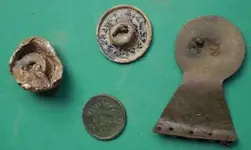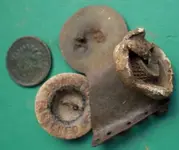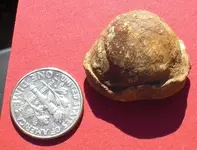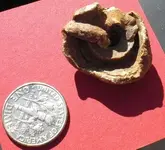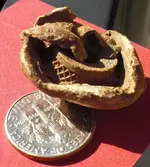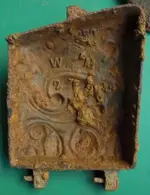Stove door almost a ringer for this one, maybe in a left-hand model?
http://antique-cast-iron-stoves.com/7/7-10_model_eclipse.php
A little history:
The Eclipse Stove Company was the predecessor of the Tappan Stove Company.
In 1881, W.J. Tappan formed the Ohio Valley Company, which manufactured cast iron stoves in Bellaire, Ohio. The Ohio Valley Company was the precursor of the Eclipse Stove Company. W.J. Tappan routinely traveled through the Ohio countryside, selling his stoves from the back of a wagon. Often, customers could not afford the stoves, so Tappan commonly accepted a combination of cash and farm produce as payment.
Tappan's business grew slowly, primarily due to too small of a market. Unfortunately for Tappan, a fire struck the Ohio Valley Company, destroying the entire production facility. Undaunted, Tappan relocated his company to Mansfield, Ohio and renamed the firm the Eclipse Stove Company. Tappan's father, who was an amateur astronomer, suggested the name after traveling to Siberia to view a comet. Now located in a more populous area of Ohio, the company grew quickly. By 1920, the firm began to sell stoves in Illinois, where another Eclipse Stove Company, which was not affiliated with Tappan's company, was in operation. To distinguish the two companies, Ohio's Eclipse Stove Company became known as the Tappan Stove Company.
Throughout the remainder of the twentieth century, the Tappan Stove Company became known for its innovative products. During the 1930s, the Tappan Stove Company introduced the first porcelain enameled stove, a stove with rounded corners, and the insulated oven. The company also invented the "see through" oven door. During World War II, the United States military used Tappan stoves to feed men in the armed forces. Tappan had manufactured a stove with wheels for the military's use, making it mobile.
During the 1940s, W.J. Tappan retired from the Tappan Stove Company, leaving his son, A.P. Tappan, in charge of the company. A.P.'s son, W.R. Tappan, assumed control of the business during the early 1950s. Under his leadership, the company experienced its greatest growth. In 1955, the Tappan Stove Company manufactured the first microwave oven for home use. The Raytheon Company had introduced microwave ovens in 1947, but these ovens were as large as a refrigerator and were too expensive for home use. At Raytheon's request, the Tappan Stove Company sought to reduce the size and cost of microwave ovens in 1952. Tappan's 1955 microwave was just twenty-four inches wide and retailed for 1,200 dollars. In 1965, the company manufactured the first combination conventional range and microwave oven, further boosting sales.
In 1979, AB Electrolux, a European manufacturing business, purchased the Tappan Stove Company. Seven years later, AB Electrolux purchased White Consolidated Industries, which manufactured Frigidaire, White-Westinghouse, Gibson, and Kelvinator products, and combined its Tappan holdings with these new products to create the WCI Major Appliances Group. In 1991, the WCI Major Appliances Group changed its name to the Frigidaire Company, reflecting the importance of the WCI Major Appliances Group's most popular product line. The Frigidaire Company, which is headquartered in Dublin, Ohio, continues to manufacture Tappan stoves.
-whynot



